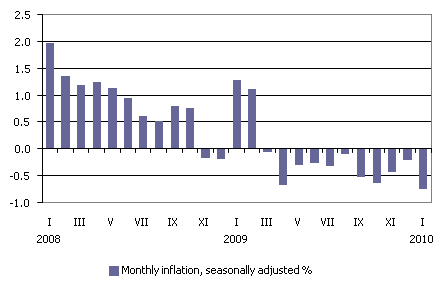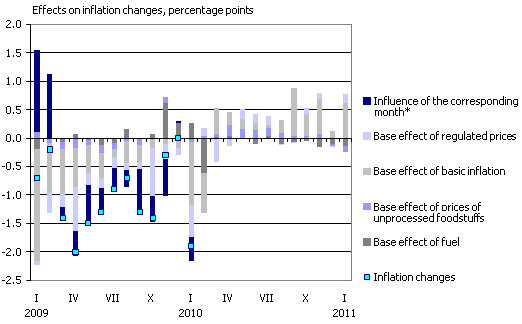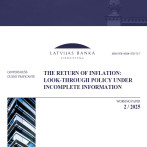The rapid drop in inflation: the role of the base effect
Over the past few years changes in inflation have been particularly pronounced. After the highest level reached in mid-2008, inflation has been dropping rapidly. Compared to January 2009, i.e. over a period of 13 months, inflation has already dropped by 14 percentage points and in February for the fifth consecutive month a year-on-year drop in prices was observed, reaching 4.2%. Among the most important factors that affected this drop, the rapid drop in domestic demand, the decreasing labour expenditures as well as the structural changes in enterprises must definitely be mentioned; the reduction in prices was also fostered by the falling energy resource prices. The rapid contraction in annual inflation, however, is not only the result of the short term contraction in prices of the respective month but the result also of the end of the influence of the changes of the previous year's prices in the respective month or the so-called "base effect."
The base effect is defined as the influence of the consumer price changes of the corresponding month of the previous year on the changes in the annual inflation of this year’s respective month It must be noted, however, that base effects have no influence on the amount of the annual inflation; annual inflation represents a precise reflection of the changes in the consumer price level over the year; the base effect helps to explain the changes in the annual inflation or the rate at which it diminishes or grows compared to the previous month. Namely, in previous February, as the rates of indirect taxes rose, a significant rise in the price level over January was observed but, as the influence of the tax rate increases on the annual changes ended, in February of this year the annual inflation has a tendency to diminish over the annual inflation in January or (since the inflation rate is negative) deflation has a tendency to grow.
In recent past, the overall economic situation has changed rapildy, causing important changes in the consumer price level as well. Price changes follow the drop in demand with a significant delay, and as Figure 1 shows, the monthly changes in consumer prices reacted to the drop in economic activity in the second half of 2008, and as of that time, a stable drop in prices has been observed. January and February of 2009 were an exception: a pronounced rise in prices was determined by increases in value added and excise tax rates.

Figure 1. Seasonally adjusted CPI changes month-on-month, %
At the beginning of 2009, the rapid drop in inflation was importantly affected by an inflation-reducing or negative base effect (See Fig. 2) or price rises in the first half of 2008. The most significant base effect was the 2008 rise in the prices of goods and services included in basic inflation; an important effect on falling inflation in 2009 was had by the administered prices that had risen in 2008, especially the energy resource tariffs. The opposite influence was exerted by the dropping fuel prices in 2008, which slowed the drop in annual changes. In January and February the rates of indirect taxes were changed significantly, causing an important rise in prices of goods and services, but, as the influence on this increase on the annual comparison of price level ended, inflation continued to drop rapidly also in January and February of 2010. In February it was 3.0 percentage points lower than in December of 2009.

Figure 2. Influences of base effects and CPI changes on inflation changes in percentage points
* the influence of the corresponding month is calculated subtracting the total base effect from total changes in inflation.
In the near future, a deflation-decreasing base effect influence on inflation dynamics is expected. That will be determined by the drop in consumer prices that began in April 2009. It is important to remember, however, that base effects provide an explanation for only one part of total inflation dynamics. As the weak demand determines a drop in the price level, the deflation-reducing or positive base effect will stabilize inflation dynamics, but it does not mean that the adjustments of consumer prices have concluded. Even though the extent of annual changes will not diminish as rapidly as observed up to now, under the influence of the continued low domestic demand and optimization of business expenditures, in the near future as well the consumer prices will decrease and deflation will be observed.
Textual error
«… …»






